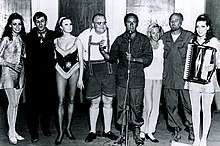Deadpan
Deadpan, dry humor or dry wit[1] is the deliberate display of a lack of or no emotion, commonly as a form of comedic delivery to contrast with the ridiculousness of the subject matter. The delivery is meant to be blunt, ironic, laconic, or apparently unintentional.
Etymology
The term deadpan first emerged as an adjective or adverb in the 1920s, as a compound word combining "dead" and "pan" (a slang term for the face). The oldest usage recorded by the Oxford English Dictionary comes from The New York Times (1928), which defines the term as "playing a role with expressionless face".[2] An example of this usage is in a scene from the 1934 film The Gay Bride in which a gangster tells a man on the other end of a phone conversation to "give it a dead pan" (with the emphasis on "pan"), so that the man does not inadvertently alert anyone else in the room as to the importance of what the gangster is about to say. The usage of deadpan as a verb ("to speak, act, or utter in a deadpan manner; to maintain a dead pan") is recorded at least as far back as 1942.[2]
Examples

Early in his vaudeville days, Buster Keaton developed his deadpan expression. Keaton realized that audiences responded better to his stony expression than when he smiled, and he carried this style into his silent film career.[3] The 1980 film Airplane! was performed almost entirely in deadpan.[4]
Many popular American sitcoms use deadpan expressions to deliver dry humor, including Curb Your Enthusiasm, Arrested Development, and My Name Is Earl. More recent examples are Andre Braugher as Captain Raymond Holt from the TV show Brooklyn Nine-Nine, Jennette McCurdy as Sam Puckett in iCarly, and Louis C.K. in Louie. Another example is the comedy of Steven Wright.[5]
Dry humor is often confused with highbrow or egghead humor, because the humor in dry humor does not exist in the words or delivery. Instead, the listener must look for humor in the contradiction between words, delivery and context. Failure to include the context or to identify the contradiction results in the listener finding the dry humor unfunny. However, the term "deadpan" itself actually refers only to the method of delivery.
Styles within deadpan
Deadpan can vary in subtlety. Obvious deadpan uses a high amount of contrast either with characters or situations. It may also take the role of mirror to characters who are unaware of their folly. More subtle deadpan can test the observational limits of the audience and even play off the audience's awareness (and thus off the implied intelligence of the audience).
See also
References
- ↑ Rishel, Mary Ann (2002). Writing humor. Detroit: Wayne State University Press. p. 166. ISBN 0-8143-2959-4.
- 1 2 Oxford English Dictionary. "dead-pan, adj., n., adv., and v." Second edition, 1989; online version December 2011. accessed 17 February 2012. First published in A Supplement to the OED I, 1972
- ↑ "Deadpan: the comedy of Buster Keaton". Telescope. CBC.ca. 17 April 1964. Retrieved 4 November 2015.
- ↑ Dudek, Duane. "25 years and still laughing; Airplane!' maintains its cruising". Milwaukee Journal Sentinel. Archived from the original on 30 April 2008. Retrieved 23 February 2009.
- ↑ Thomas, E.C. (2014). The Everything Big Book of Jokes: Hundreds of the Shortest, Longest, Silliest, Smartest, Most Hilarious Jokes You've Never Heard!. Adams Media. p. 16. ISBN 978-1-4405-7698-0. Retrieved June 29, 2017.
External links

